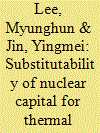| Srl | Item |
| 1 |
ID:
126621


|
|
|
|
|
| Publication |
2013.
|
| Summary/Abstract |
In Korea, price subsidies for industrial power are provided by the government in order to enhance industrial competitiveness and curb inflation. However, this repeatedly causes electricity shortages in the peak summer and winter seasons because of over-consumption. Forcing a decline in the demand for electricity by raising power rates would thus help prevent a national blackout, lowering dependence on foreign energy and reducing CO2 emissions cost-effectively. This paper simulates the effects of a rise in power rate on demand for electricity and output price by estimating a restricted cost function, in which the quantity of raw materials is set to its cost-minimizing level, jointly with an inverse supply relation for the top three electricity-intensive manufacturing sectors. The empirical results indicate that a 10% increase in electricity rate would result in 8.0-10.1% less demand across all three manufacturing sectors, ceteris paribus. The impact on output price is of little statistical significance in the basic metals sector, while output price on average falls by 0.16% in the TV and communication equipment sector.
|
|
|
|
|
|
|
|
|
|
|
|
|
|
|
|
| 2 |
ID:
109646


|
|
|
|
|
| Publication |
2011.
|
| Summary/Abstract |
Korea plans to introduce an emissions trading scheme for the controlling greenhouse gas emissions in 2015. Using Shephard's (1970) output distance function, we first estimate the shadow price of CO2 for power generators in the Korean fossil-fueled electric generation industry. Then, by assuming that each power generator is required to reduce CO2 emissions by one ton, we compute the potential cost savings from internal trading among generators within the same plant and from external trading across plants at prevailing market prices. The results indicate that, on average, the generators paid $14.63 to abate one ton of CO2 emissions in 2007. Plants realized additional gains through external trading. In particular, cost savings from trades between different fuel-fired plants were substantial.
|
|
|
|
|
|
|
|
|
|
|
|
|
|
|
|
| 3 |
ID:
117001


|
|
|
|
|
| Publication |
2012.
|
| Summary/Abstract |
As part of ongoing efforts to reduce CO2 emissions by increasing the proportion of the energy mix relying on nuclear power, it may be useful to substitute nuclear power for thermal power wherever possible, thereby substantially reducing the need to use fossil fuels. In order to evaluate the contribution of nuclear power to potential CO2 reduction, this study examines the substitutability of thermal capital and nuclear capital in the Korean electric power industry by utilizing the input distance function. Additionally, the unit costs of thermal capital and nuclear capital are compared in terms of their shadow prices, which are defined as the opportunity costs inherent to one additional unit of capital increase deriving from a reduction in labor. The empirical results presented herein indicate that nuclear capital is readily substituted for thermal capital, but the substitutability of thermal capital for nuclear capital is relatively low. The shadow price ratio of nuclear capital to thermal capital is estimated to be 15.9, on average, showing an upward trend over the years from 1982 to 2010.
|
|
|
|
|
|
|
|
|
|
|
|
|
|
|
|